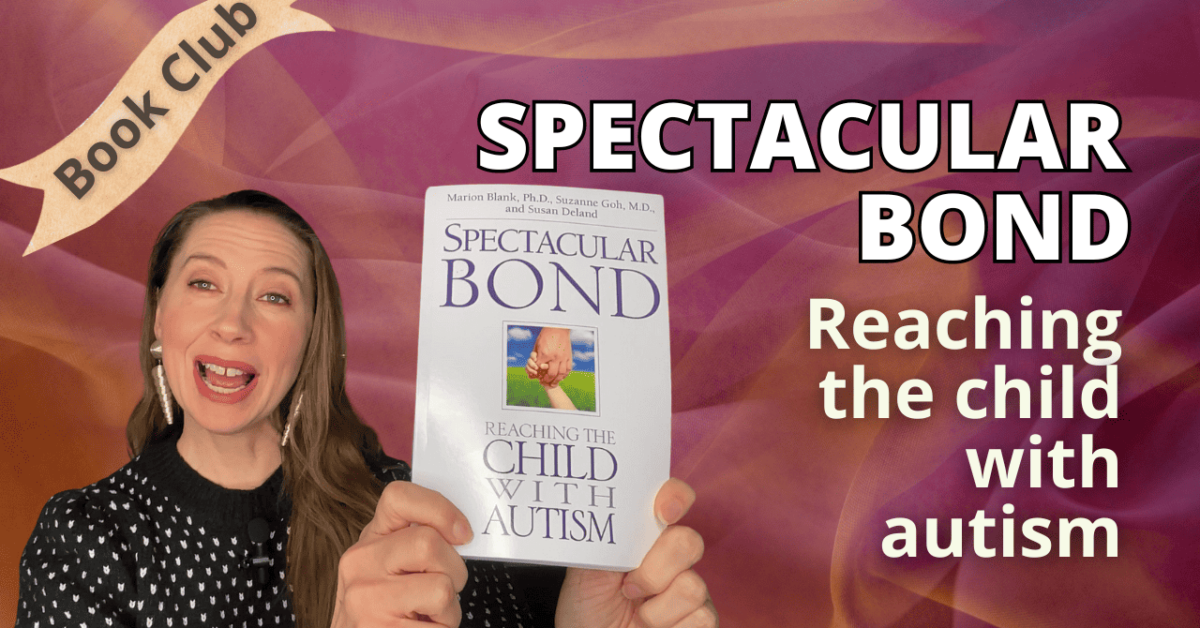It’s Book Club time. All right, the book that everyone voted on is Spectacular Bonds: Reaching the Child with Autism.
It’s written by three people, and it’s a very interesting mix. It gives a perspective from
- a developmental psychologist,
- a pediatric neurologist, and
- a parent of a child who has autism.
You get some really good perspectives in one book.
For whom is this book?
In the introduction of the book, it goes over, ‘Is this book right for me?’ And so this book is really meant for you if you have a child between the ages of two and six. It can be used for older kids, but this book and the activities in it are really geared towards the younger child.
This book is really about the introduction of the Spectacular Bond program. That’s what they refer to it in the book.
When your child isolates themselves
In the beginning, it talks about something that a lot of parents experience. It’s when the child isolates themselves, and they don’t really want to interact with you, interact with anybody else, or do anything, along those lines.
The authors here take the position that – parents are there to provide guidance. The whole goal, whether the child has autism or not, is for parents to give that guidance so that ultimately there’s independence. If you let the child isolate and be on their own, you’re not really fulfilling the job you have as a parent.
The authors say that there’s a balance. So alone time certainly is important to have, but you can’t always want to be alone and just want to withdraw. The book goes into, How do you approach that? How do you have that balance? How do you actually get the child to want to interact with you?
Clear communication
The book also goes into this really common situation. You might ask your child, “Can you say hi to mommy?” Or anyone else who walks in the room? We might ask them another question, “Can you get your shoes on? Can you get in the car? Can you get your coat on?” These are all questions, but they’re really disguised as demands because you really don’t want them to say no. There’s only one answer. Can you get your shoes on? And you do not even really want a verbal answer to that question. It is – “I’m telling you to get your shoes on, get your shoes on”. But it’s phrased as a question. And so the authors say that in situations like that, this can start to confuse the child.
So if you have a child who struggles with language and communication, you’re asking them a question, which typically you would want a verbal response, but you don’t really want a verbal response. That question is really about telling them what to do. That’s why it’s disguised and a little bit on the tricky side.
The book points out some really good examples of where clarity might not be at its highest, even with the parents using verbal communication. It’s pretty interesting to think about, right?
Stimming
There’s a large section in this book about managing self-stimulatory behaviors – stimming. The book says, I’ll read a quote here,
“They are entirely within the child’s control.”
So this book says stimming is entirely within the person with autism’s control, and that stimming is done to help tune out the world. This combination, those two reasons, that’s what provides the child comfort, and that is why the stimming is done, according to this book.
The book goes on to discuss why are situations overwhelming for some people and not for others. It goes through the example of clothing and how clothing can feel restrictive or uncomfortable. It might rub on the skin. Your child might be starting out with this level of frustration that is growing just from the clothing. You might not even know that because I’m sure you wouldn’t make your child wear clothes that would cause them discomfort. But this is how those overwhelming situations occur when it seems like, wait, what’s overwhelming? There’s this buildup.
Controlled exchanges
They have a whole section of the program. They have many pages about stimming, and in many ways, how do you control it? They term it ‘controlled exchanges’. So this book says, controlled exchanges allow the children to slowly and systematically alter their behaviors. So if that’s something that you’re interested in learning more about, you can certainly pick up this book, there are quite a few pages on it.
At-home program
And this book does lay out a program, the At-home program, of how to address certain issues in autism. They do suggest filming yourself and reviewing the film. I always find it best to work with a professional when you’re doing that kind of thing, because a professional can see something really quickly. You pay money for their expertise. So you definitely want to do that. If you’re filming yourself and analyzing yourself, you’ll see things, but you won’t change at the pace that you want; as fast as if you had a professional giving their input.
So this is a good home program, but you really would want somebody who has experience to weigh in on what you’re doing.
‘Not now’
In one of the practices that this book has, it talks about using two powerful words, ‘not now’. And that’s in how they address certain meltdown behaviors. So meltdowns and tantrums, they talk about ‘not now’.
The book also goes through a list of common questions that parents might have as they’re going through the program and doing the exercises. One question here is, “Will my child think that I’m not available to her, and will she stop interacting with me altogether?” The answer here is: “Children on the spectrum, even more than neurotypical children, treasure predictable, safe patterns of interaction. In general, you will find your child interacting more with you and interacting more fully with you as you create clear, simple, comprehensible patterns.”
Final words
I certainly wouldn’t recommend this book to everybody. It’s very specific, so specific to the age, 2-6. It’s also specific to if you really want to do a lot of the interventions on your own. And I really would advise, if you’re going to do some of these exercises, hiring a professional to review the videos so that you can learn faster.





